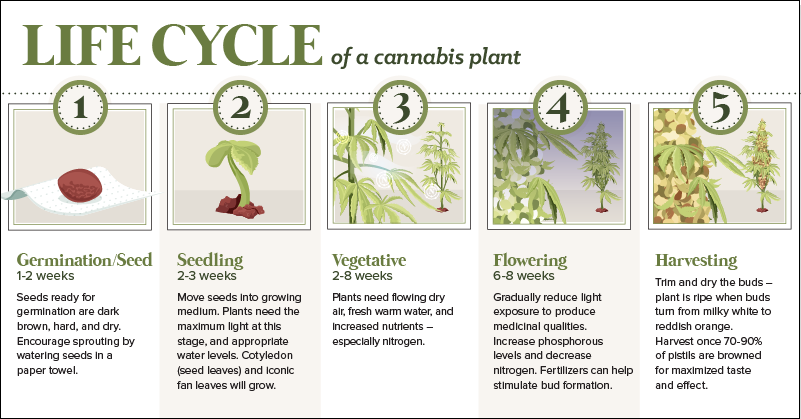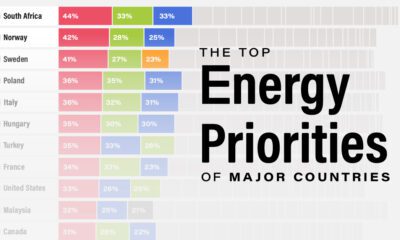Cannabis
The Anatomy of a Cannabis Plant, and its Lifecycle

Anatomy of a Cannabis Plant
By 2027, it’s projected that the legal cannabis market in the U.S. and Canada could hit $47.3 billion in size.
That will make it bigger than annual global sales for raw metals like nickel and silver put together. It would be a size that even exceeds the North American pork market.
But while almost everyone has a sense of the basic mechanics of mining or ranching, knowledge around the essentials of cannabis are understandably not as well ingrained in our culture.
Cannabis Plants 101
Today’s infographic comes to us from The Green Organic Dutchman, and it breaks down the anatomy of a cannabis plant, the differences between types of plants, and also the basics around cannabis cultivation.
Here are some of the more important things you need to know about the plant:
Plant Anatomy
Commercial cannabis comes from the female species, which have long skinny stems and large, iconic fan leaves. The plant is trimmed down into buds, which come together in a cola at the top of the stem.
Trichomes are a blanket of crystal resin coating the cannabis plant, and they contain both terpenes and cannabinoids.
Cannabinoids
The two most well-known cannabinoids are THC and CBD, which also occur in the largest volume.
Delta-9-tetrahydrocannabinol (THC) is known to cause psychoactive effects or the “high” felt from cannabis.
Effects: pain relief, anti-nausea, sleep aid, appetite and mood stimulant.
Cannabidiol (CBD) lacks nearly any psychoactive effect, making it preferred as a medicine.
Effects: pain relief, anti-nausea, anti-inflammatory, anti-anxiety, seizure reduction.
Other cannabinoids such as cannabichromene (CBC), cannbigerol (CBG), and cannabinol (CBN), have similar therapeutic properties. Research is also validating the plant’s efficacy in treating medical conditions such as cancer, multiple sclerosis, PTSD, and Alzheimer’s.
Terpenes
Terpenes are organic, aromatic compounds found in the oils of all flowers, including cannabis. Interestingly, these oils have their own independent medical potential that is waiting to be unlocked.
Cannabinoids and terpenes work in harmony, resulting in an “entourage effect” and enhances the medical properties of cannabis
Sativa, Indica, Hybrid
There are two common types of cannabis plants: sativa and indica.
Sativa plants have long and thin leaves that are lighter in color. Buds are long and wispy, and feature red or orange coloring. They tend to contain high THC and low CBD levels – optimal for daytime use, described as being energizing, stimulating, and creative.
Indica plants have leaves that are wide, broad, and deep in color. Buds are dense and tightly packed, featuring purple coloring. Indica usually contains medium levels of THC, and a higher amount of CBD. Its effects are often described as being relaxing and calming, which is more optimal for nighttime use.
It’s also worth noting that hybrid strains can often bring together the best qualities of both into one plant.
The Lifecycle of a Cannabis Plant
Every stage of growth of a cannabis plant needs different care:
1. Germination (Seed): 1-2 weeks
Seeds ready for germination are dark brown, hard, and dry. Encourage sprouting by watering seeds in a paper towel.
2. Seedling: 2-3 weeks
Move seeds into growing medium. Plants need the maximum light at this stage, and appropriate water levels. Cotyledon (seed leaves) and iconic fan leaves will grow.
Light: 18-24 hours
Humidity: 70%
Temperature: 20-25°C
3. Vegetative: 2-8 weeks
Plants need flowing dry air, fresh warm water, and increased nutrients – especially nitrogen. It’s important at this stage to separate male and female plants before pollination to prevent female plants producing seeds instead of trichomes.
Light: 12 hours sunlight (18 hours fluorescent light)
Humidity: 50%
Temperature: 20-24°C
4. Flowering: 6-8 weeks
Gradually reduce light exposure to produce medicinal qualities. Increase phosphorous levels and decrease nitrogen. Fertilizers can help stimulate bud formation.
Light: 12 hours
Humidity: 40-50%
Temperature: 20-28 °C
5. Harvesting
Trim and dry the buds. The plant is ripe when buds turn from milky white to reddish orange. Harvest once 70-90% of pistils are browned for maximized taste and effect.
Humidity: 50%
Temperature: 20-25°C
As the cannabis industry matures, consumers will demand the highest-quality products. Growing cannabis in a natural environment is increasingly vital to create a premium end-product.
In the next part of this series, we will dive into various growing methods and the benefits of organic methods on quality and effects of cannabis.
Politics
Timeline: Cannabis Legislation in the U.S.
At the federal level, cannabis is illegal, but state laws differ. This graphic looks at the timelines of cannabis legislation in the U.S.
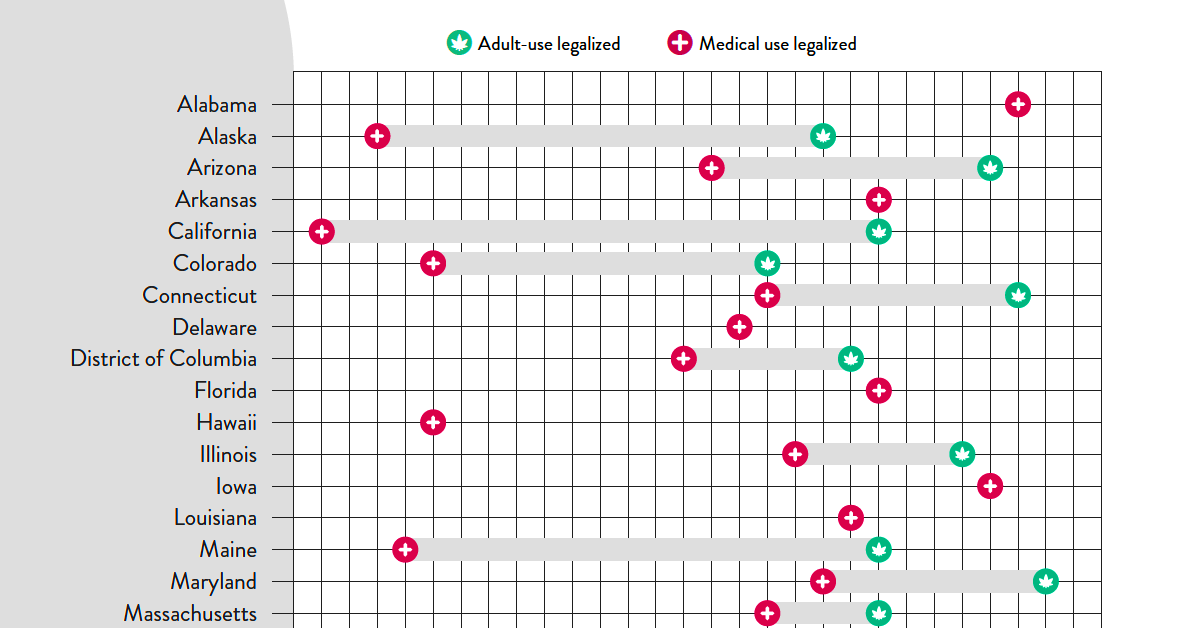
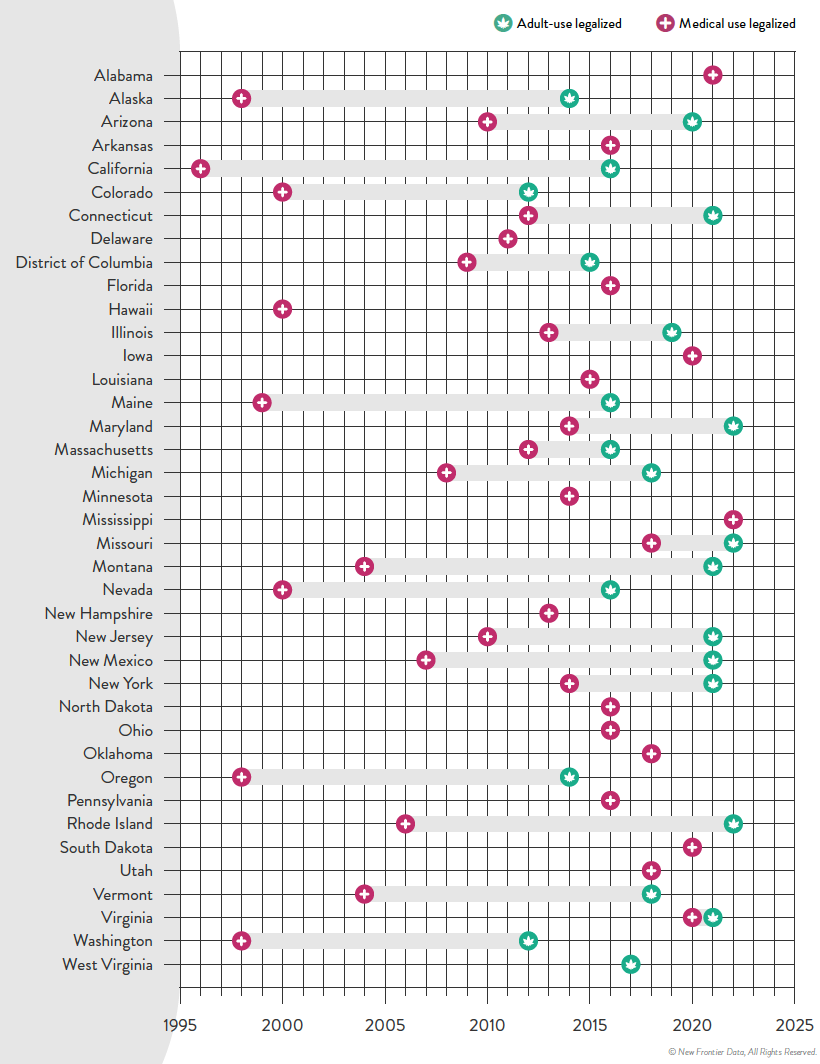
Timeline: Cannabis Legislation in the U.S.
At the federal level, cannabis is still considered an illegal substance. That said, individual states do have the right to determine their own laws around cannabis sales and usage.
This visual from New Frontier Data looks at the status of cannabis in every state and the timeline of when medical and/or recreational use became legal.
Cannabis Through the Years
In the U.S., the oldest legalese concerning cannabis dates back to the 1600s—the colony of Virginia required every farm to grow and produce hemp. Since then, cannabis use was fairly wide open until the 1930s when the Marihuana Tax Act was enforced, prohibiting marijuana federally but still technically allowing medical use.
Jumping ahead, the Controlled Substances Act was passed in 1970, classifying cannabis as Schedule I drug—the same category as heroin. This prohibited any use of the substance.
However, the 1970s also saw a counter movement, wherein many states made the move towards decriminalization. Decriminalization means that although possessing cannabis remained illegal, a person would not be subject to jail time or prosecution for possessing certain amounts.
By the 1990s, some of the first states passed laws to allow the medical usage of cannabis, and by 2012 two states in the U.S.—Washington and Colorado—legalized the recreational use of cannabis.
Cannabis Legislation Today and Beyond
The MORE Act (the Marijuana Opportunity Reinvestment and Expungement Act) was passed in the House early 2022, and if made law, it would decriminalize marijuana federally.
“This bill decriminalizes marijuana. Specifically, it removes marijuana from the list of scheduled substances under the Controlled Substances Act and eliminates criminal penalties for an individual who manufactures, distributes, or possesses marijuana.”– U.S. Congress
Cannabis still remains illegal at the federal level, but at the state levels, cannabis is now fully legal (both for medicinal and recreational purposes) in a total of 22 states.
Over 246 million Americans have legal access to some form of marijuana products with high THC levels. Looking to the future, many new cannabis markets are expected to open up in the next few years:
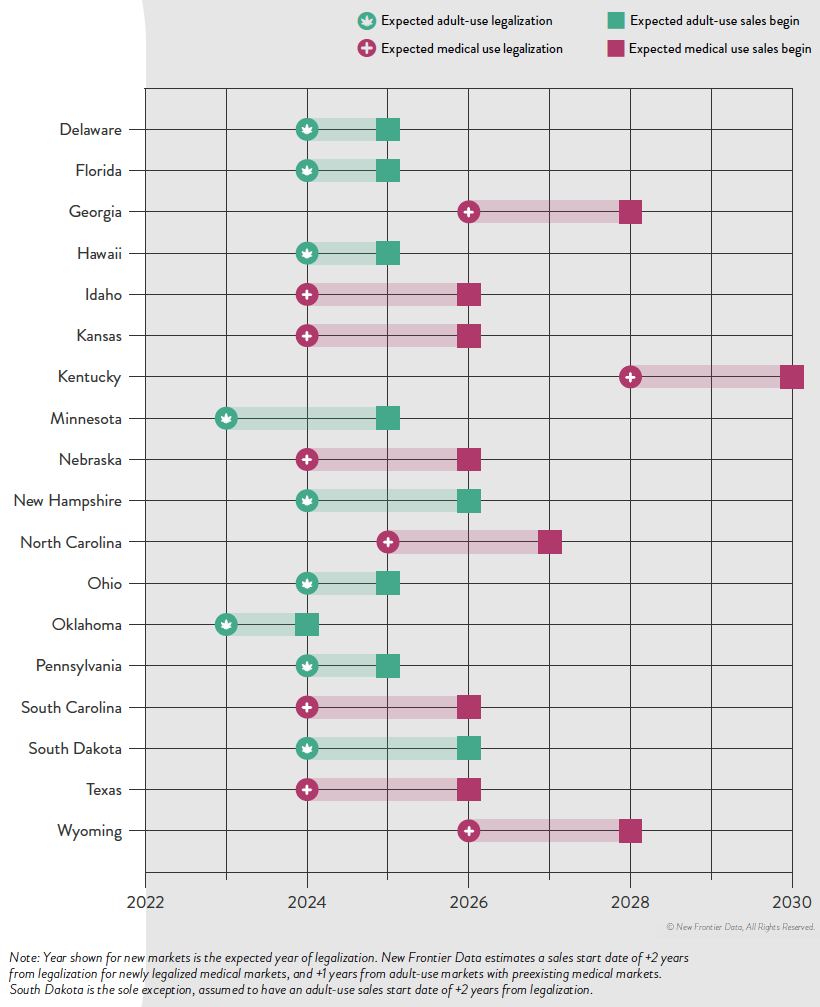
The earliest states expected to open up next for recreational cannabis sales are Minnesota and Oklahoma. There is always a lag between legalization and actual sales, wherein local regulatory bodies and governments set standards. States like Kentucky, on the other hand, aren’t likely to even legalize medicinal cannabis until 2028.
It’s estimated that by 2030, there will be 69 million cannabis consumers in the country, up 33% from 2022.
Overall, the U.S. cannabis market is likely an important one to watch as legal sales hit $30 billion in 2022. By the end of the decade, that number is expected to be anywhere from $58 billion to as much as $72 billion.
-

 Green1 week ago
Green1 week agoRanked: The Countries With the Most Air Pollution in 2023
-

 Automotive2 weeks ago
Automotive2 weeks agoAlmost Every EV Stock is Down After Q1 2024
-

 AI2 weeks ago
AI2 weeks agoThe Stock Performance of U.S. Chipmakers So Far in 2024
-

 Markets2 weeks ago
Markets2 weeks agoCharted: Big Four Market Share by S&P 500 Audits
-

 Real Estate2 weeks ago
Real Estate2 weeks agoRanked: The Most Valuable Housing Markets in America
-

 Money2 weeks ago
Money2 weeks agoWhich States Have the Highest Minimum Wage in America?
-

 AI2 weeks ago
AI2 weeks agoRanked: Semiconductor Companies by Industry Revenue Share
-

 Travel2 weeks ago
Travel2 weeks agoRanked: The World’s Top Flight Routes, by Revenue









